Light Shelves Optimization for Daylight Improvement in Typical Public Classrooms in Saudi Arabia
Abstract
1. Introduction
2. Literature Review
2.1. Classroom Design
2.2. Daylight and Windows
2.3. Light Shelves
2.4. Time Factor
2.5. Preliminary Studies through Simulation Programs
3. Methodology
- 300 lux: Classrooms, tutorial rooms; music practice rooms; computer practice rooms; language laboratories;
- 500 lux: Lecture halls; art rooms; practical rooms and laboratories; handicraft rooms; libraries and reading areas;
- 750–1000 lux: Technical drawing room;—art rooms in art schools.
4. Selected Classroom/Research Sample
5. Simulation of Existing Designs
5.1. Calibration with Simulation Model
5.2. Daylight Simulation for the Models of the Selected Classrooms
5.3. Cases Selected to Study the Effects of Light Shelves
6. Simulating the Different Types of Light Shelves
- -
- First case (western orientation, 09:00, 21 Dec.)
- -
- Second case (northern orientation, 09:00, 21 Dec.)
7. Conclusions
Author Contributions
Funding
Conflicts of Interest
References
- Pellegrino, A.; Cammarano, S.; Savio, V. Daylighting for Green Schools: A Resource for Indoor Quality and Energy Efficiency in Educational Environments. Energy Procedia. 2015, 78, 3162–3167. [Google Scholar] [CrossRef]
- Mohsenin, M.; Hu, J. Assessing daylight performance in atrium buildings by using Climate Based Daylight Modeling. Sol. Energy 2015, 119, 553–560. [Google Scholar] [CrossRef]
- Roisin, B.; Bodart, M.; Deneyer, A.; D’Herdt, P. Lighting energy savings in offices using different control systems and their real consumption. Energy Build. 2008, 40, 514–523. [Google Scholar] [CrossRef]
- Boubekri, M.; Cheung, I.N.; Reid, K.J.; Wang, C.H.; Zee, P.C. Impact of Windows and Daylight Exposure on Overall Health and Sleep Quality of Office Workers: A Case-Control Pilot Study. J. Clin. Sleep Med. 2014, 10, 603–611. [Google Scholar] [CrossRef] [PubMed]
- Read, A. Integration of Daylighting into Educational (School) Building Design for Energy Efficiency, Health Benefit, and Mercury Emissions Reduction Using Heliodon for Physical Modeling; Rochester Institute of Technology: Rochester, NY, USA, 2017. [Google Scholar]
- Tregenza, P.; Wilson, M.P. Daylighting: Architecture and Lighting Design; Psychology Press: London, UK, 2011; p. 290. [Google Scholar]
- Mott, M.S.; Robinson, D.H.; Walden, A.; Burnette, J.; Rutherford, A.S. Illuminating the Effects of Dynamic Lighting on Student Learning. SAGE Open 2012, 2, 215824401244558. [Google Scholar] [CrossRef]
- Hobday, R. Myopia and daylight in schools: A neglected aspect of public health? Perspect Public Health 2016, 136, 50–55. [Google Scholar] [CrossRef] [PubMed]
- Jakubiec, J.; Reinhart, C. The ‘adaptive zone’—A concept for assessing discomfort glare throughout daylit spaces. Light. Res. Technol. 2012, 44, 149–170. [Google Scholar] [CrossRef]
- Gadelhak, M.; Aly, M.; Sabry, H. High Performance Facades: The Effect of Sun Breakers on Daylighting Performance and Energy Consumption in South Oriented Office Spaces. In Proceedings of the Architectural Engineering Conference 2013, State College, PA, USA, 3–5 April 2013; pp. 776–784. [Google Scholar]
- Evola, G.; Gullo, F.; Marletta, L. The role of shading devices to improve thermal and visual comfort in existing glazed buildings. Energy Procedia. 2017, 134, 346–355. [Google Scholar] [CrossRef]
- Shernoff, D.J.; Ruzek, E.A.; Sinha, S. The influence of the high school classroom environment on learning as mediated by student engagement. Sch. Psychol. Int. 2017, 38, 201–218. [Google Scholar] [CrossRef]
- Barrett, P.; Zhang, Y.; Moffat, J.; Kobbacy, K. A holistic, multi-level analysis identifying the impact of classroom design on pupils’ learning. Build. Environ. 2013, 59, 678–689. [Google Scholar] [CrossRef]
- Drosou, N.; Mardaljevic, J.; Haines, V. Uncharted territory: Daylight performance and occupant behaviour in a live classroom environment. In Proceedings of the 6th VELUX Daylight Symp, London, UK, 2–3 September 2015; pp. 4–7. [Google Scholar]
- Obralic, A.; Jeghel, S. The Case Study on Significance of Daylight in Classroom Setting at Sarajevo Campus. ESJ 2021, 17, 19. Available online: https://eujournal.org/index.php/esj/article/view/13927 (accessed on 15 May 2022). [CrossRef]
- Wu, W.; Ng, E. A review of the development of daylighting in schools. Light. Res. Technol. 2003, 35, 111–124. [Google Scholar] [CrossRef]
- Barrett, P.; Davies, F.; Zhang, Y.; Barrett, L. The impact of classroom design on pupils’ learning: Final results of a holistic, multi-level analysis. Build. Environ. 2015, 89, 118–133. [Google Scholar] [CrossRef]
- Plympton, P.; Conway, S.; Epstein, K. Daylighting in Schools: Improving Student Performance and Health at a Price Schools Can Afford. Paper presented at American Solar Energy Society Conference, NREL/CP-550-28049, Madison, WI, USA, 16–21 June 2000. [Google Scholar]
- Kelting, S.; Montoya, M. Green Building Policy, School Performance, and Educational Leaders’ Perspectives in USA. In Proceedings of the Sixth International Conferences on Construction in the 21st Century, Kuala Lumpur, Malaysia, 5–7 July 2011. [Google Scholar]
- Benfield, J.A.; Rainbolt, G.N.; Bell, P.A.; Donovan, G.H. Classrooms With Nature Views: Evidence of Differing Student Perceptions and Behaviors. Environ. Behav. 2015, 47, 140–157. [Google Scholar] [CrossRef]
- Ander, G.D. Daylighting; Southern California Edison: Rosemead, CA, USA, 2016. [Google Scholar]
- Zomorodian, Z.S.; Korsavi, S.S.; Tahsildoost, M. The Effect of Window Configuration on Daylight Performance in Classrooms: A Field and Simulation Study. IJAUP 2016, 26, 15–24. [Google Scholar]
- Mehta, D. A Review on Challenges of Daylight-Based-Classroom-Studies and their Methodology Regarding Architectural-Design-Process. Int. J. Innov. Res. Sci. Eng. Technol. 2020, 9, 15. [Google Scholar]
- Ruck, N.; Aschehoug, Ø.; Aydinli, S.; Christoffersen, J.; Courret, G.; Edmonds, I.; Jakobiak, R.; Kischkoweit-Lopin, M.; Klinger, M.; Lee, E.S.; et al. Daylight in Buildings A source book on daylighting systems and components; Lawrence Berkeley National Laboratory: Berkeley, CA, USA, 2000.
- Atre, U. Effect of Daylighting on Energy Consumption and Daylight Quality in an Existing Elementary School. Master’s Thesis, University of Mumbai, May, 2005. [Google Scholar]
- Tuaycharoen, N.; Tregenza, P.R. View and discomfort glare from windows. Light. Res. Technol. 2007, 39, 185–200. [Google Scholar] [CrossRef]
- Samiou, A.I.; Doulos, L.T.; Zerefos, S. Daylighting and artificial lighting criteria that promote performance and optical comfort in preschool classrooms. Energy Build. 2021, 258, 111819. [Google Scholar] [CrossRef]
- Costanzo, V.; Evola, G.; Marletta, L.; Pistone Nascone, F. Application of Climate Based Daylight Modelling to the Refurbishment of a School Building in Sicily. Sustainability 2018, 10, 2653. [Google Scholar] [CrossRef]
- Meresi, A. Evaluating daylight performance of light shelves combined with external blinds in south-facing classrooms in Athens, Greece. Energy Build. 2016, 116, 190–205. [Google Scholar] [CrossRef]
- Atre, U.; Clayton, M. Energy Efficient Elementary School Design: Effect of daylighting on energy consumption and space illuminance in an existing elementary school. ARCC Conf. Repos. 2019, 1, 1. Available online: https://www.arcc-journal.org/index.php/repository/article/view/822 (accessed on 5 July 2022).
- Lee, H. Performance evaluation of a light shelf with a solar module based on the solar module attachment area. Build. Environ. 2019, 159, 106161. [Google Scholar] [CrossRef]
- Liu, Y. Development of a Light Shelf Design Assistant Tool. Master’s Thesis, University of Southern California, Los Angeles, CA, USA, 2013. [Google Scholar]
- Sabry, H.M.K. The impact of daylighting-guiding systems on indoor natural light penetration: Simulation analysis for light-shelves. In Proceedings of the PLEA 2006-23rd International Conference on Passive and Low Energy Architecture, Geneva, Switzerland, 6–8 September 2006. [Google Scholar]
- Kontadakis, A.; Tsangrassoulis, A.; Doulos, L.; Zerefos, S. A Review of Light Shelf Designs for Daylit Environments. Sustainability 2017, 10, 71. [Google Scholar] [CrossRef]
- Alama, A.; Sabbagh, M. Comparing Daylight Distribution between two Classroom Prototypes in Jeddah Public Schools. In Proceedings of the 86th Research World International Conference, Jeddah, Saudi Arabia, 14 March 2020. [Google Scholar]

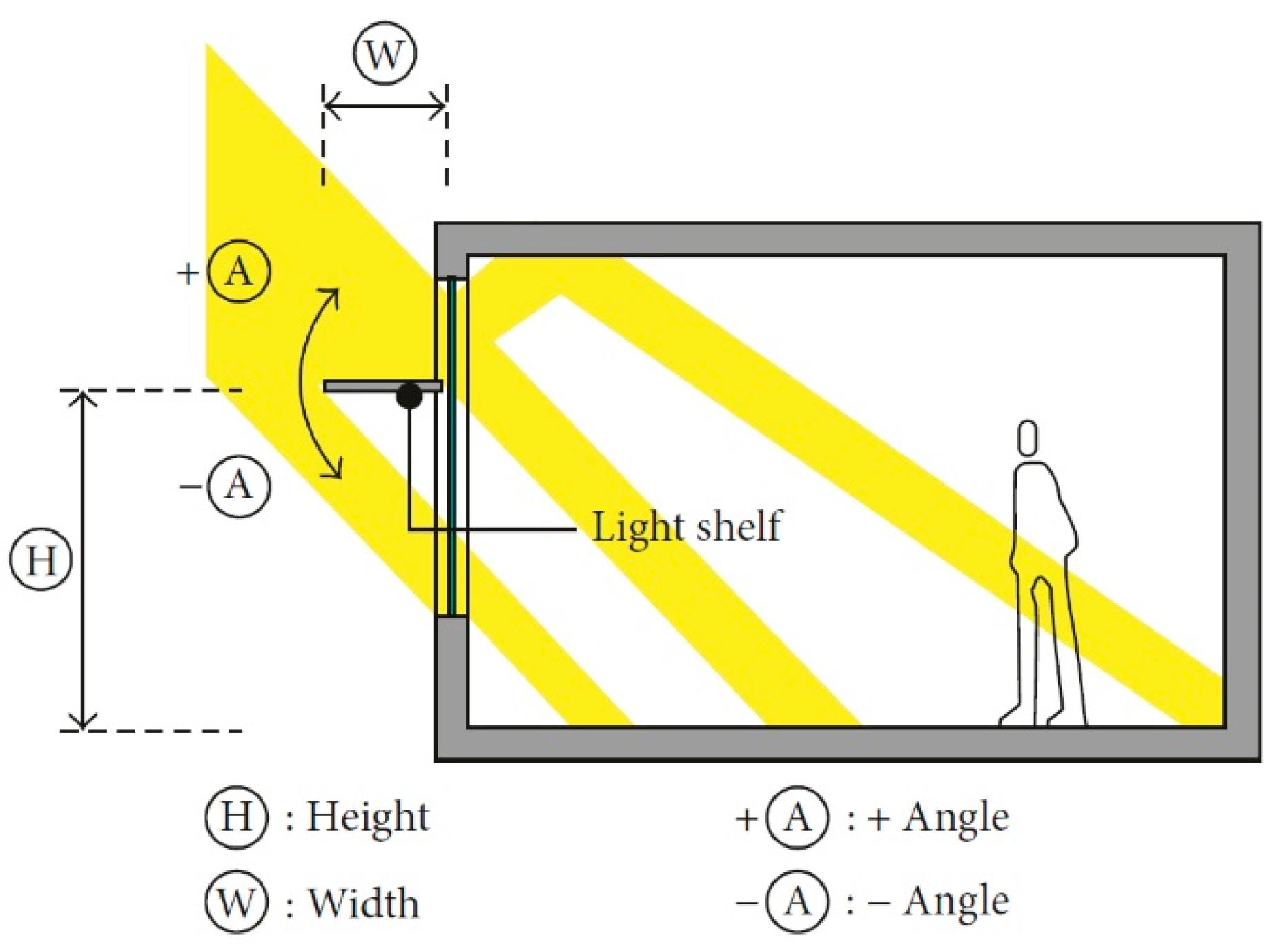

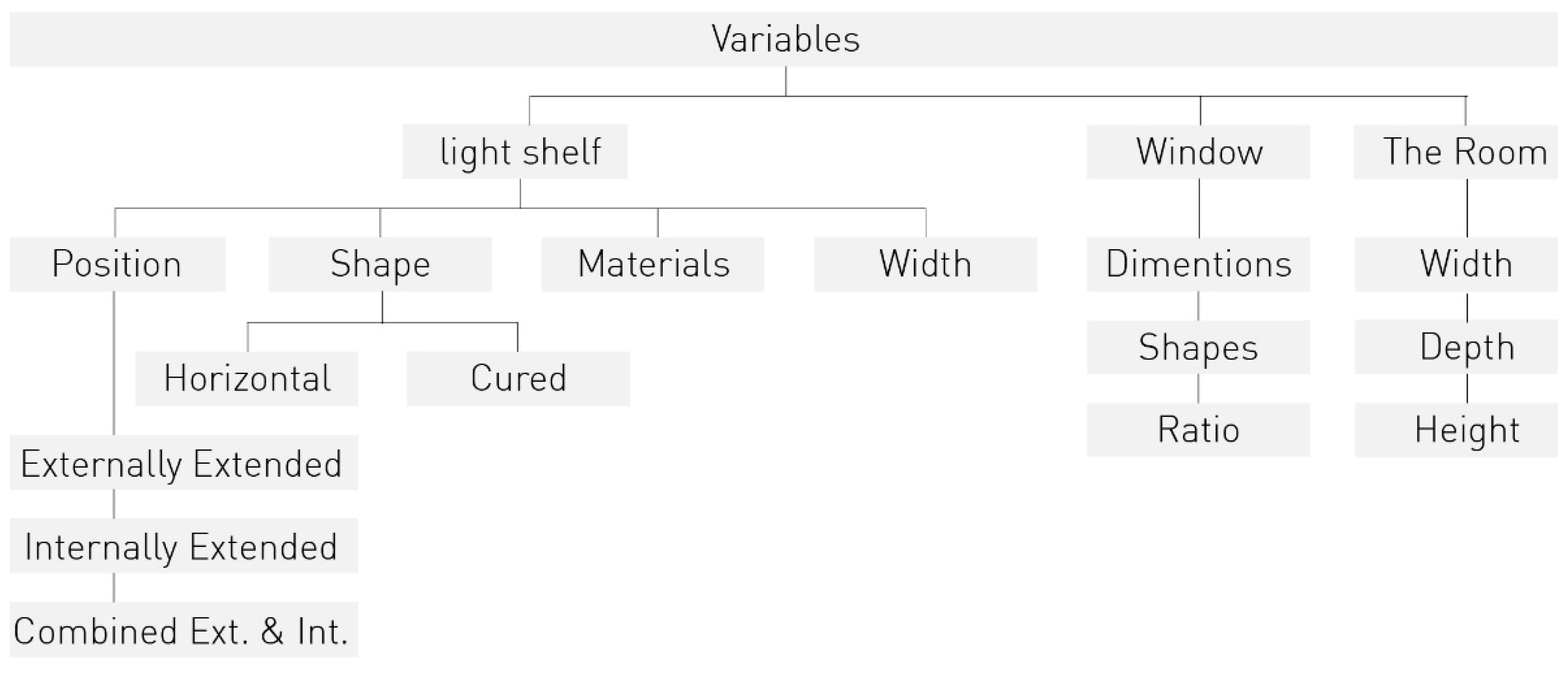

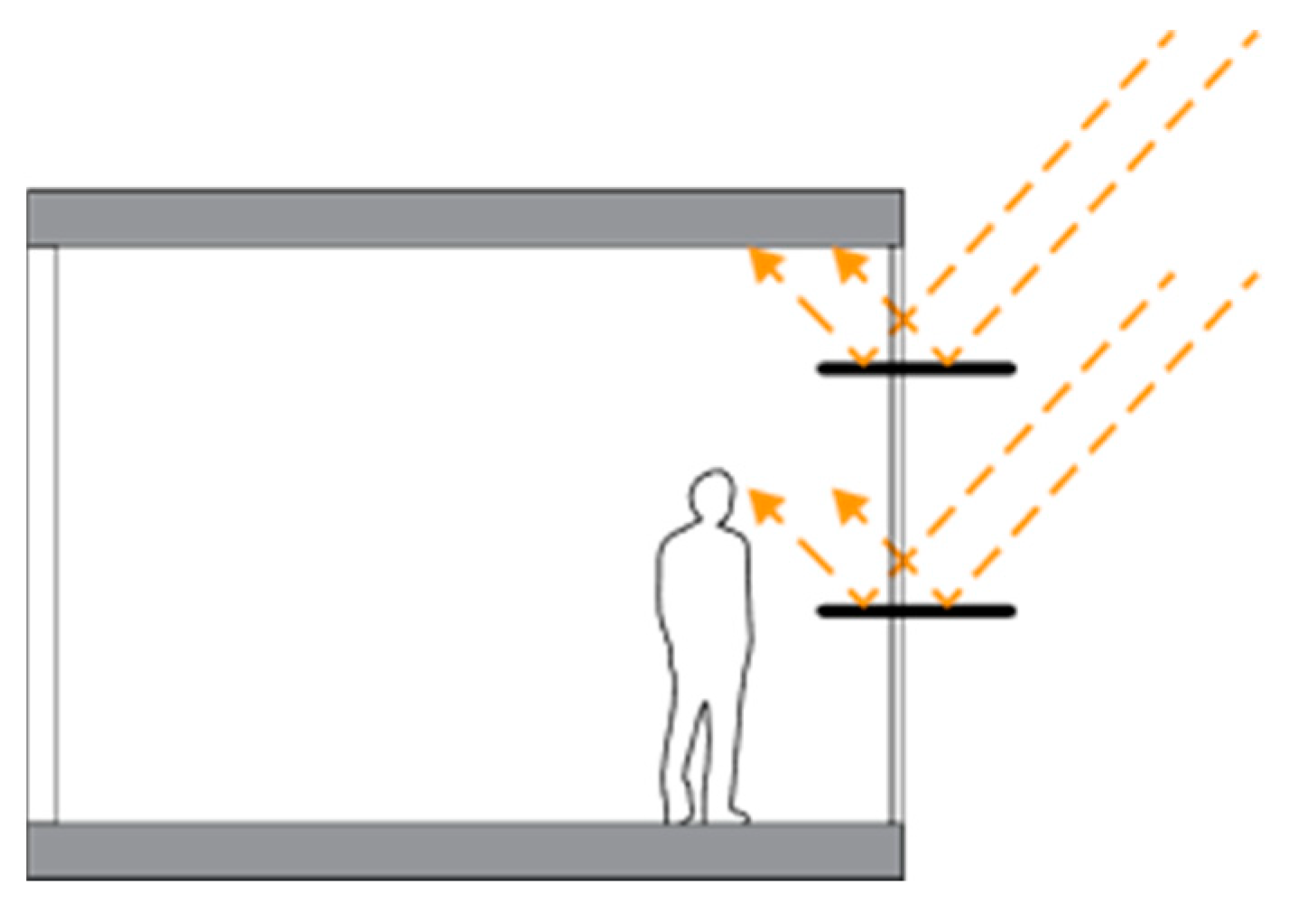

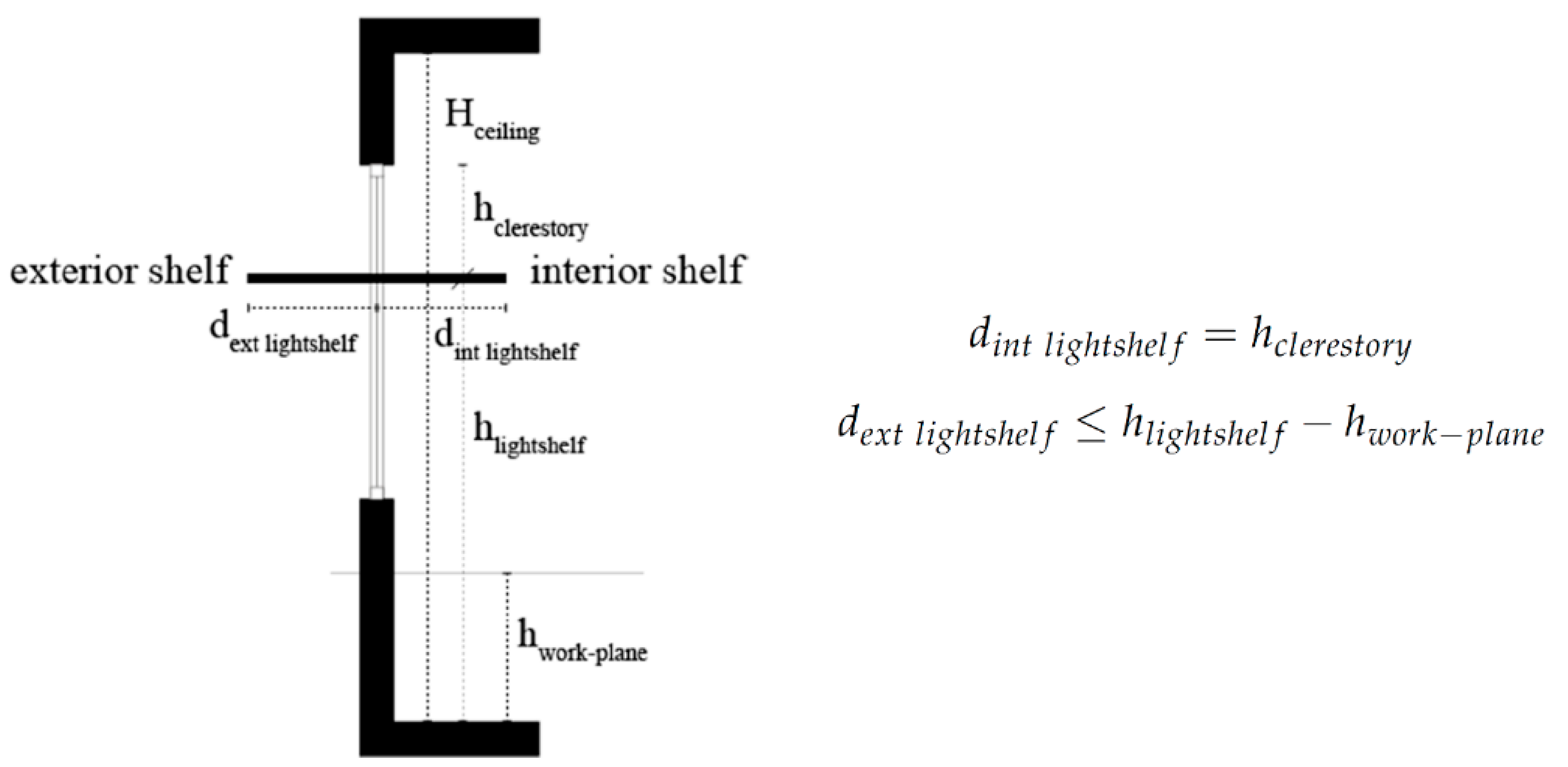
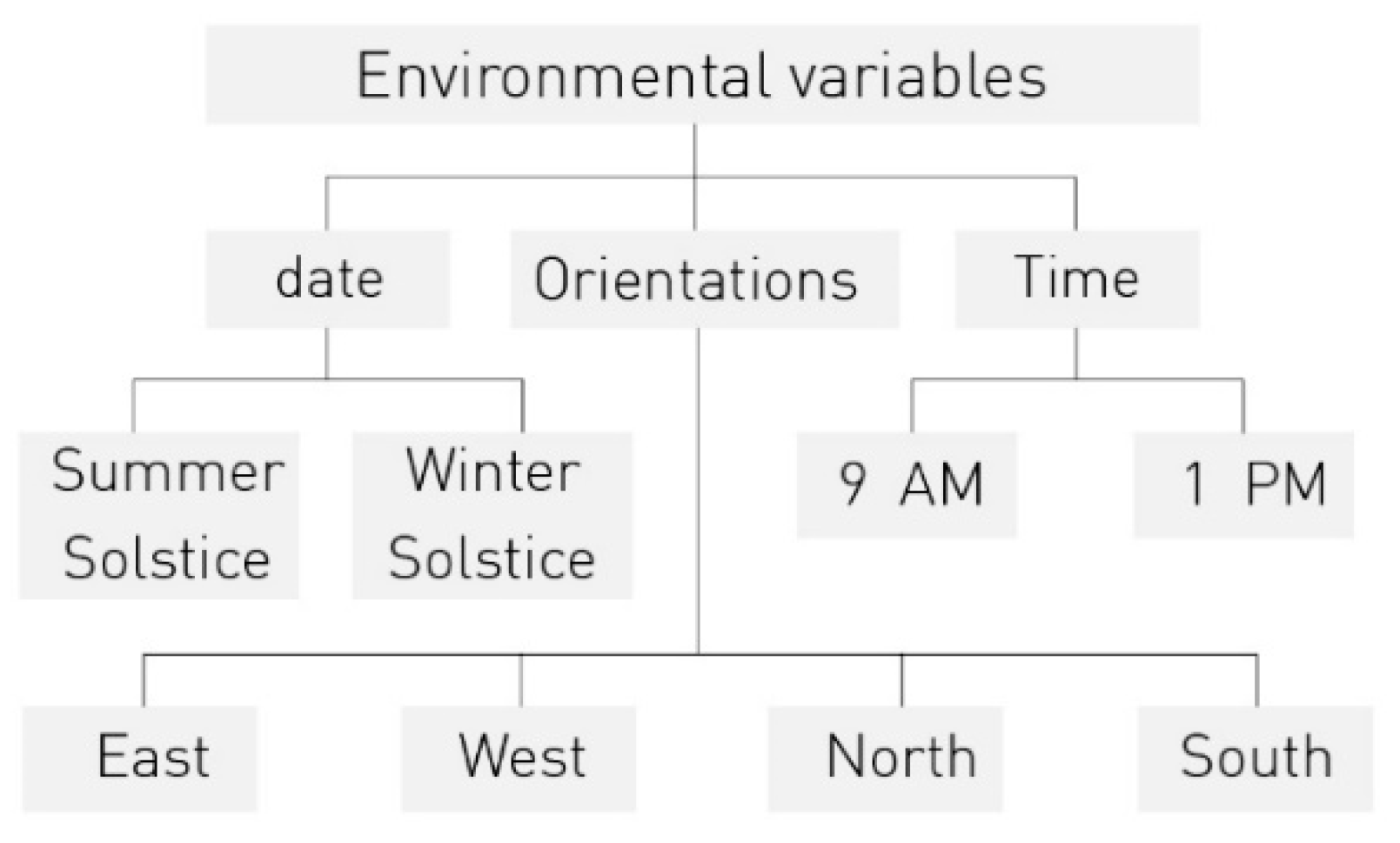
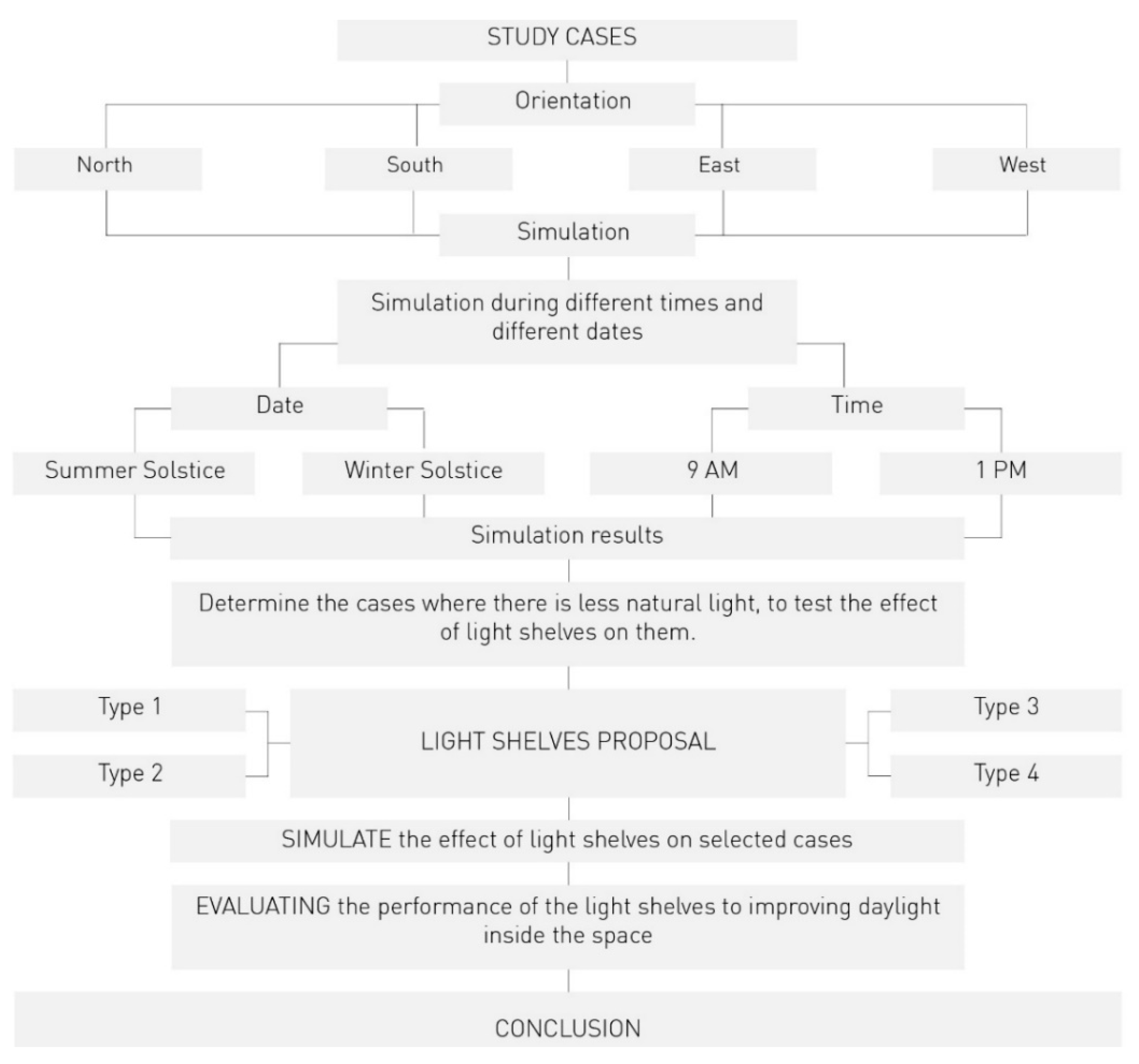
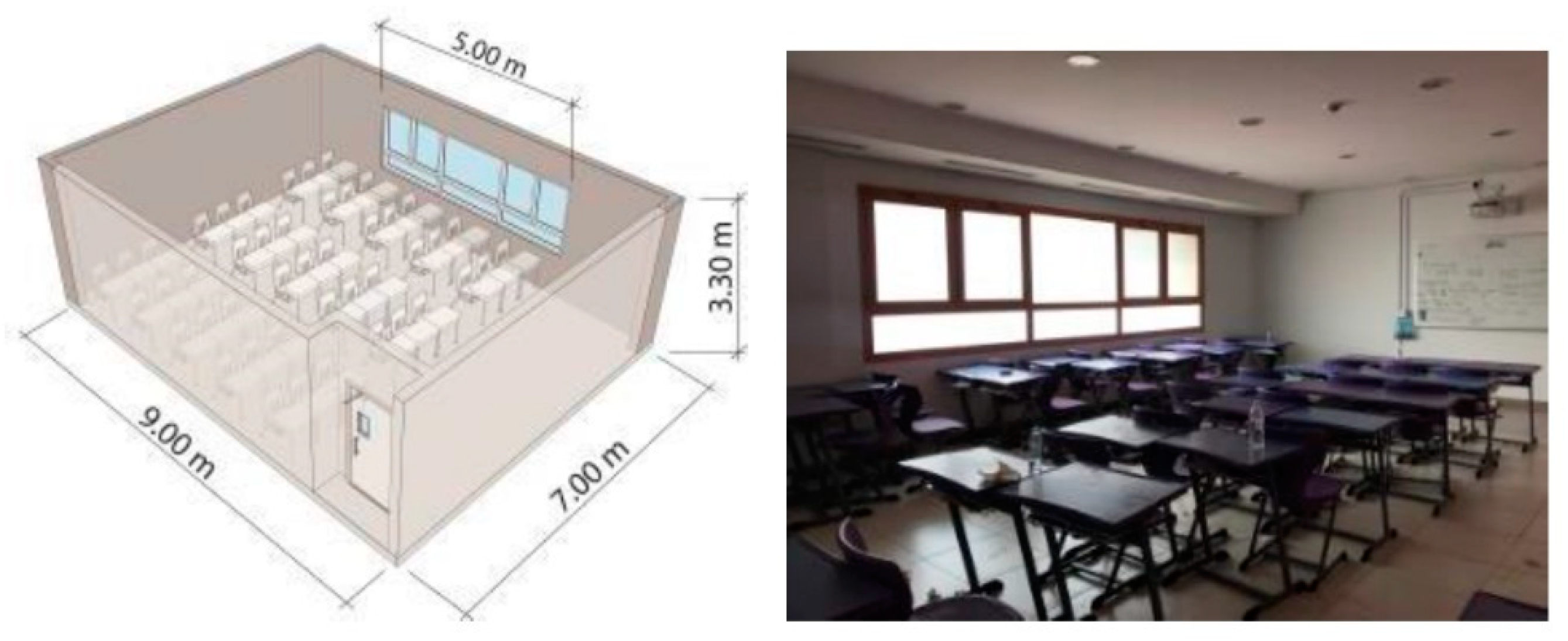
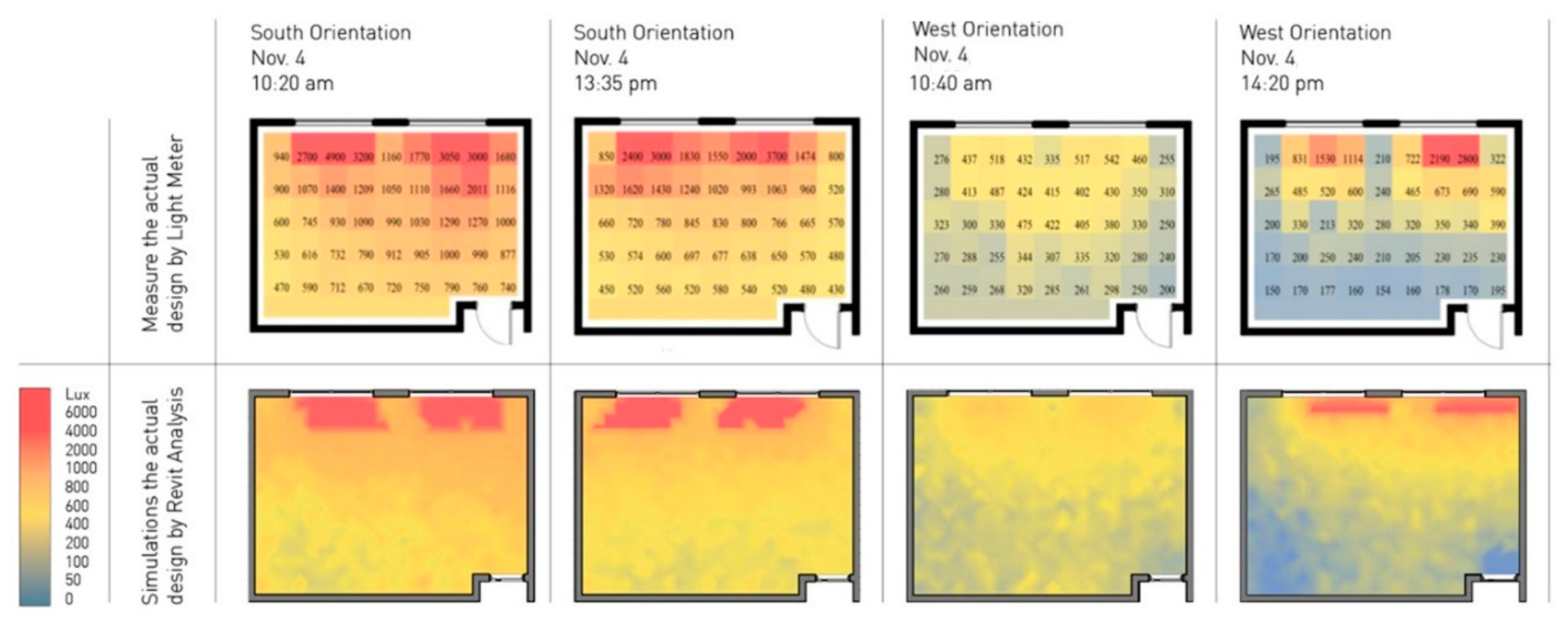
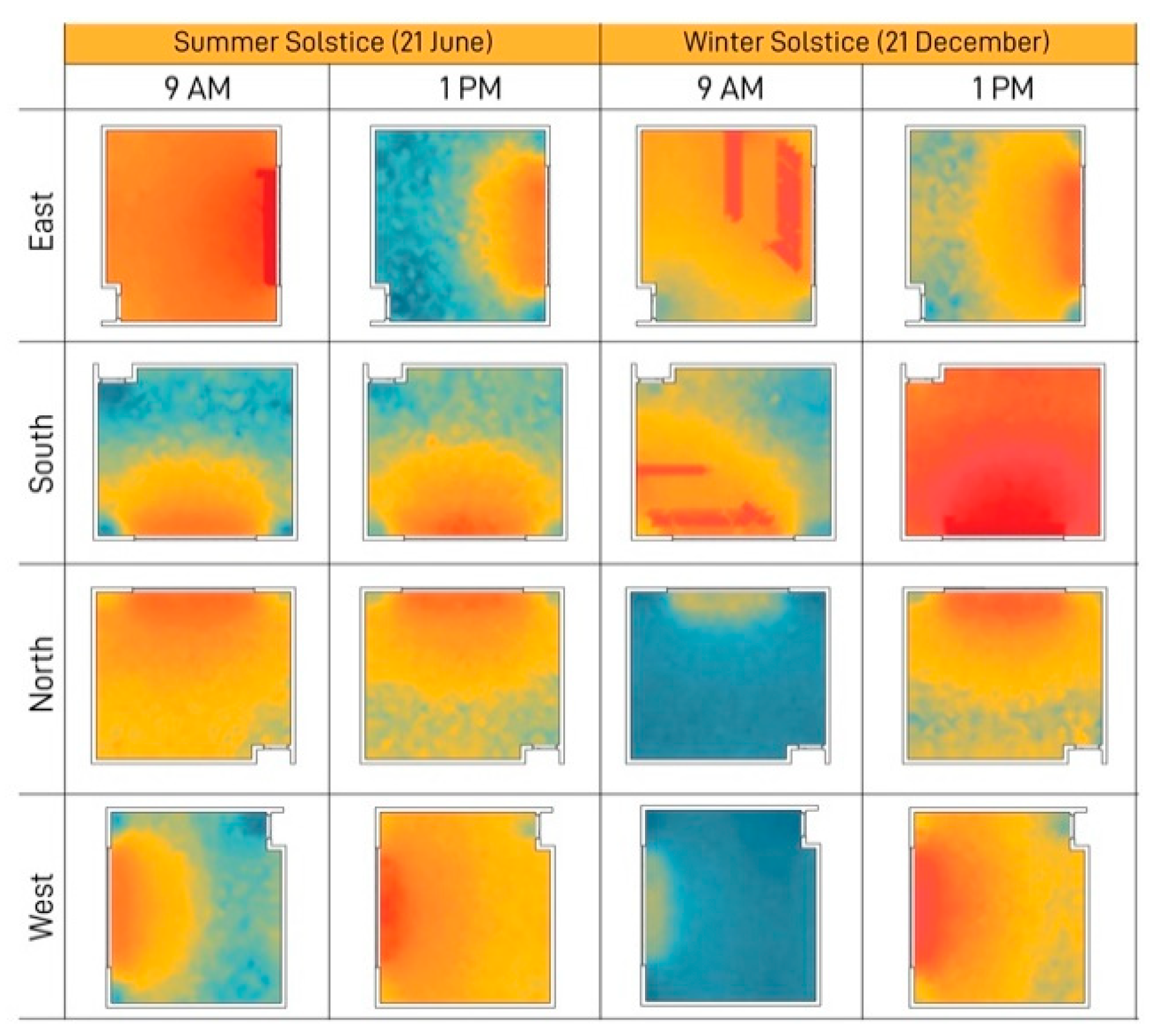


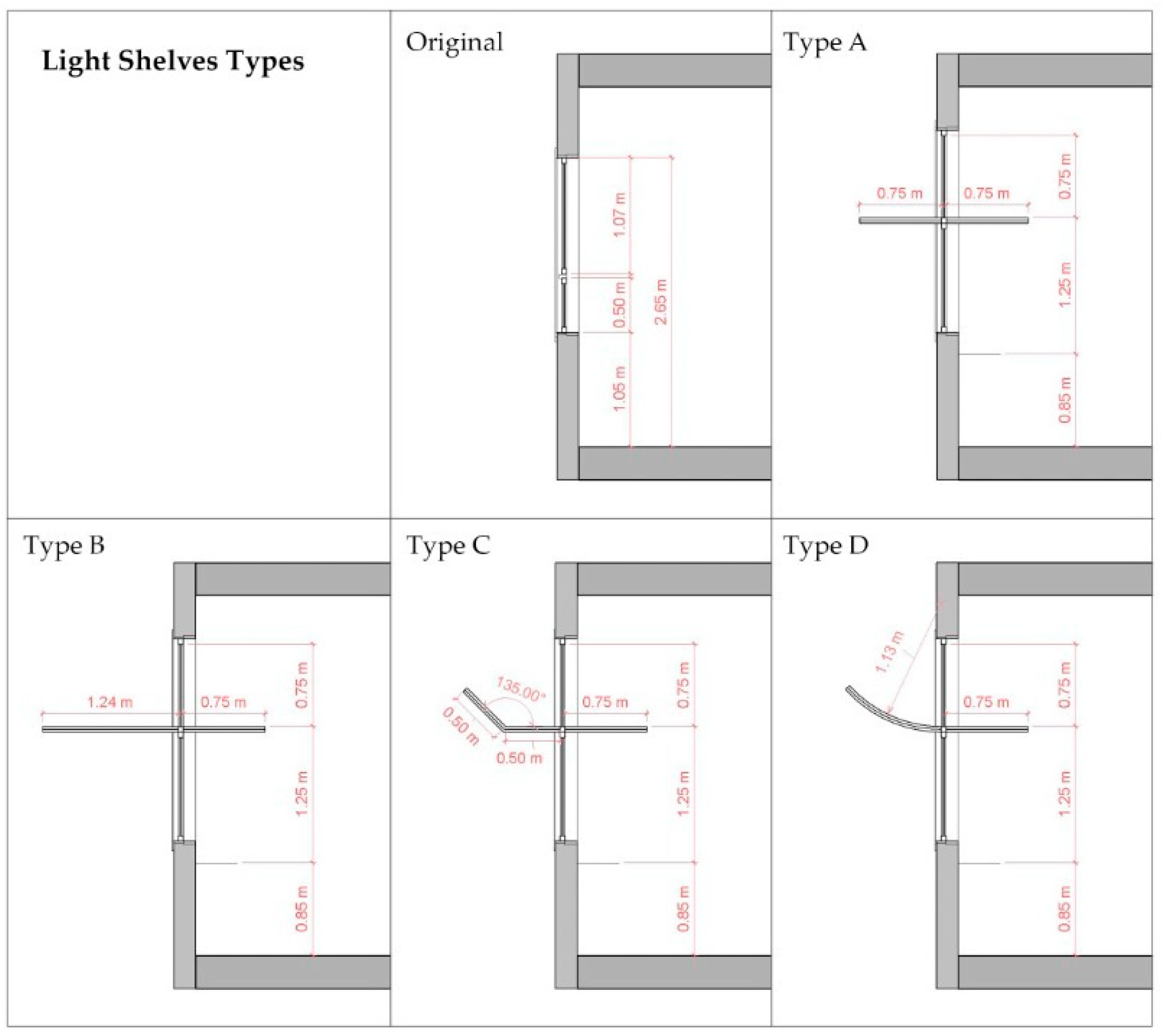

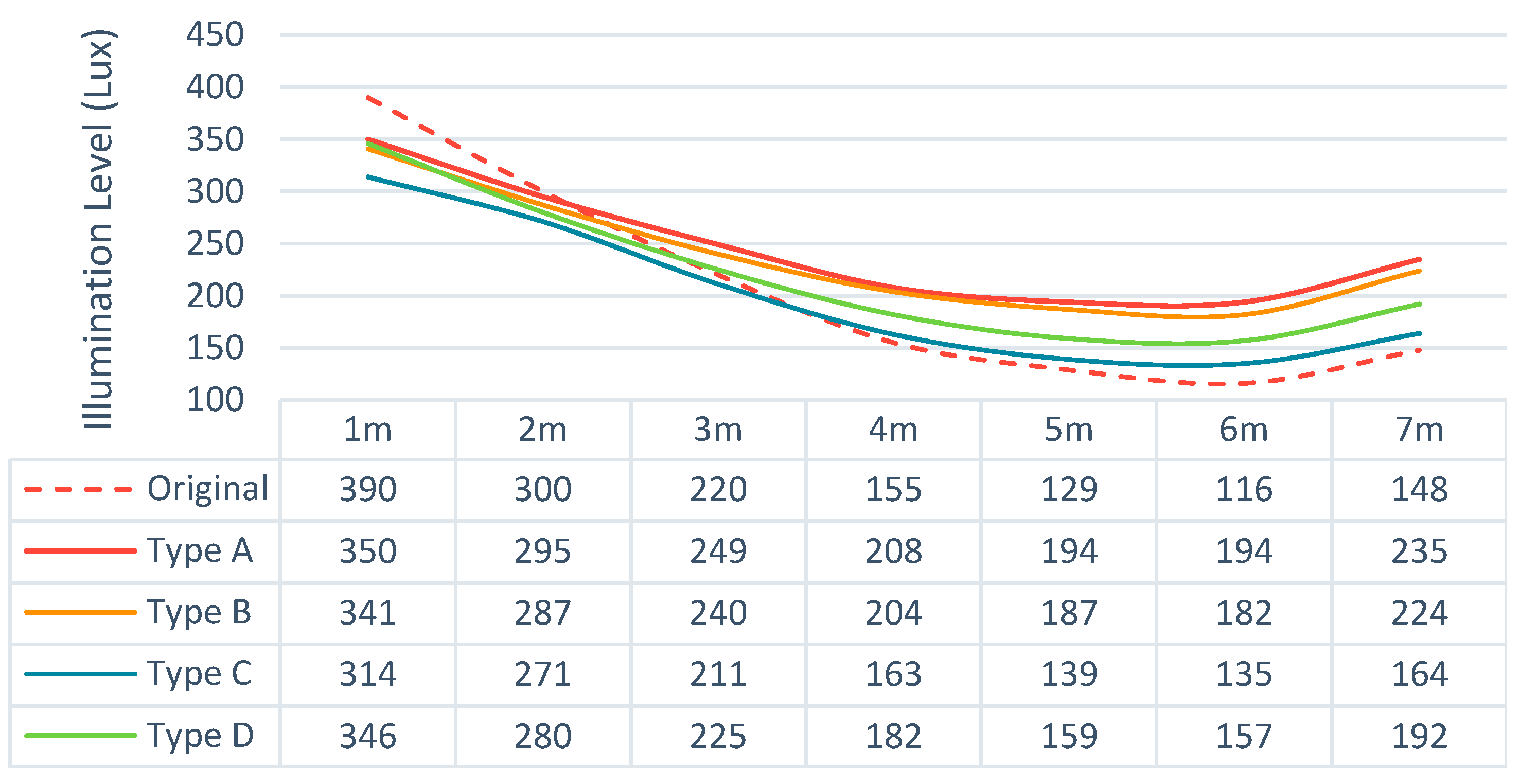

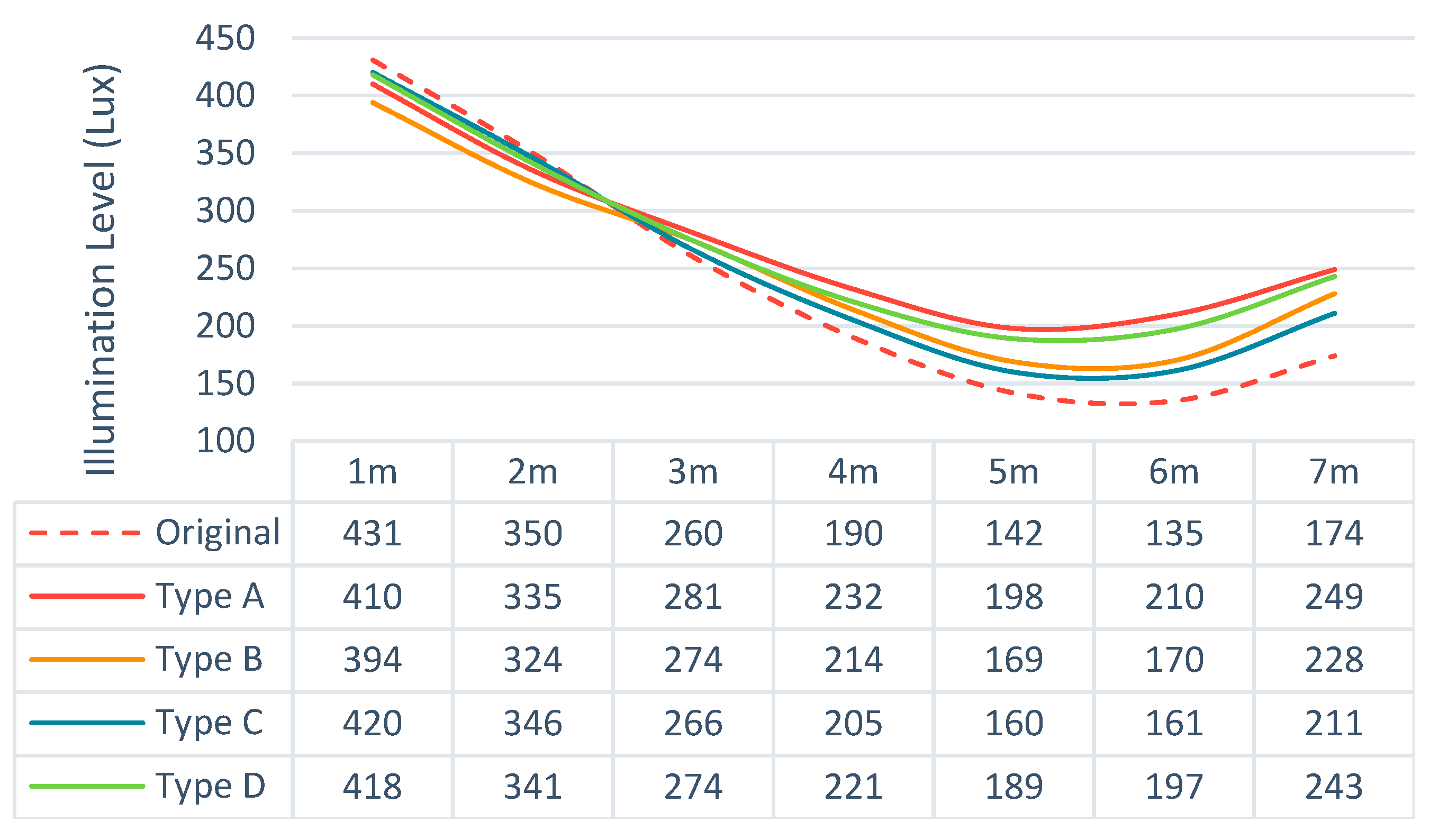
| Classroom Dimension (m) | Area (m2) | Window Size (m) |
|---|---|---|
| 9 L × 7 W × 3.3 H | 63 | 5 W × 1.6 H |
| Category | Element | Classroom—School A | Classroom—School B |
|---|---|---|---|
| Furniture layout | Desk and chair | Communal tables in groups of five students each | Desks and chairs facing the whiteboard |
| Teaching equipment | Type | Projector, whiteboard, interactive smart board | Projector, whiteboard |
| Surface material and finish | Walls | Painted | Painted |
| Flooring | 60 × 60 cm ceramic tiles | 60 × 60 cm ceramic tiles | |
| Ceiling | False ceiling, painted | False ceiling, painted, with a drop bulkhead for AC ducting | |
| Component | Reflectance | |
|---|---|---|
| Internal walls | 0.70 | White |
| Floor | 0.40 | Polished granite |
| Ceiling | 0.80 | Flat |
| Windows | Transmittance | |
| Glazing | 0.55 | Double glazing |
| Others | Specifications | |
| Surroundings | No obstruction from adjacent buildings 0.75m | |
| Simulation plane height | ||
| During Morning | North Orientation | East Orientation | West Orientation | South Orientation |
|---|---|---|---|---|
| Min. | 116 Lux | 300 Lux | 200 Lux | 470 Lux |
| Avg. | 390 Lux | 470 Lux | 390 Lux | 980 Lux |
| Max. | 550 Lux | 1025 Lux | 2800 Lux | 4900 Lux |
| During Afternoon | North Orientation | East Orientation | West Orientation | South Orientation |
|---|---|---|---|---|
| Min. | 233 Lux | 150 Lux | 150 Lux | 430 Lux |
| Avg. | 360 Lux | 290 Lux | 360 Lux | 830 Lux |
| Max. | 668 Lux | 602 Lux | 2800 Lux | 3700 Lux |
Publisher’s Note: MDPI stays neutral with regard to jurisdictional claims in published maps and institutional affiliations. |
© 2022 by the authors. Licensee MDPI, Basel, Switzerland. This article is an open access article distributed under the terms and conditions of the Creative Commons Attribution (CC BY) license (https://creativecommons.org/licenses/by/4.0/).
Share and Cite
Sabbagh, M.; Mandourah, S.; Hareri, R. Light Shelves Optimization for Daylight Improvement in Typical Public Classrooms in Saudi Arabia. Sustainability 2022, 14, 13297. https://doi.org/10.3390/su142013297
Sabbagh M, Mandourah S, Hareri R. Light Shelves Optimization for Daylight Improvement in Typical Public Classrooms in Saudi Arabia. Sustainability. 2022; 14(20):13297. https://doi.org/10.3390/su142013297
Chicago/Turabian StyleSabbagh, Mostafa, Siraj Mandourah, and Raghda Hareri. 2022. "Light Shelves Optimization for Daylight Improvement in Typical Public Classrooms in Saudi Arabia" Sustainability 14, no. 20: 13297. https://doi.org/10.3390/su142013297
APA StyleSabbagh, M., Mandourah, S., & Hareri, R. (2022). Light Shelves Optimization for Daylight Improvement in Typical Public Classrooms in Saudi Arabia. Sustainability, 14(20), 13297. https://doi.org/10.3390/su142013297






